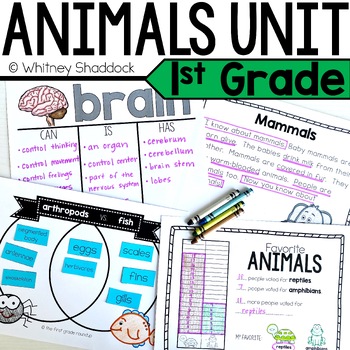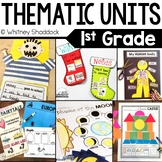Animal Classification Unit with Animal Characteristics and Needs For Each Group
- Zip
Also included in
- Are you struggling to fit science and social studies in your busy first grade schedule? Look no further! These six science and social studies thematic units for 1st grade are planned in detail and ready to use. Each of the 6 first grade units begins with a content big idea and then integrates intoPrice $85.00Original Price $117.55Save $32.55
Description
Give kids hands on experience learning about the human body and animal characteristics and animal needs all while integrating first grade science into your literacy block! This 6 week animal classification unit was written for first grade, but is perfect for any K-2 classroom!
Perfect for Kinder Next Gen Science Standards on staying alive. (K-LS1-1)
BIG IDEA FOR THIS ANIMAL CLASSIFICATION UNIT
"Needs for survival determine the characteristics of living things."
This thematic unit is part of an entire year of science and social studies content. Find the bundle and SAVE here!
WHAT IS A FIRST GRADE INTEGRATED THEMATIC UNIT?
My integrated thematic units include 6 weeks of extremely detailed weekly and daily fables lesson plans in reading, writing and social studies and/or science. The list of COMMON CORE STANDARDS tied to activities are included as well as all materials needed to teach the lessons, anchor charts and templates.
By purchasing this unit, you will have a completely integrated plan for this thematic unit and all the tools you need to teach for 6 weeks!
WHY SHOULD I USE THEMATIC UNITS IN MY FIRST GRADE CLASSROOM?
Let's be honest! We don't have a ton of time for science or social studies in first grade. So when we teach it, we need to be able to get a good bang for our buck. Integrating content into our literacy block helps us cover our content standards while also reinforcing our literacy standards. Read more about how I squeeze science and social studies into my first grade weekly schedule in this blog post.
INCLUDED IN THIS HUMAN BODY & ANIMAL CLASSIFICATION UNIT
- 6 weeks of weekly visual plans for science, guided reading, writing, math, read alouds
- daily detailed lesson plans for science and writing
- 60 I can objective cards for literacy, math and science
- 43 vocabulary cards for a science word wall
- 30 animal photo cards for sorting into animal groups (mammals, birds, fish, amphibians, reptiles, arthropods)
- Informative writing graphic organizer (completed and a blank template to fill in with students)
- 2 writing anchor chart templates (color & BW): I am an Expert, How To Teach Our Readers
- 21 science anchor charts (color, BW, & digital): animal classification, mammals, birds, reptiles, fish, amphibians, arthropods (each animal group has 2 charts covering different animal characteristics, plus an editable digital template), bones, muscles, brain, heart, lungs, stomach, intestines, kidneys
- 14 reading passages: brain, heart, lungs, stomach, intestines, kidneys, muscles, bones, and the 6 animal groups
- 7 Writing prompts: mammals, birds, fish, arthropods, amphibians, reptiles, What would you do with a tail like this?
- Science writing booklet for animals: "A _____ is a mammal because ____." (a page for each animal group)
- 3 Venn Diagrams: mammals vs. birds, arthropods vs. fish, amphibians vs. reptiles)
- 3 graphs charting favorite animal groups
- collaborative animal research webs and graphic organizers, writing paper, and publishing activities
- Human body collaborative poster: large human body organs for adding to life-size butcher paper bodies in groups.
- Human body project: small human body organs for adding to mini-me human, plus labels!
- My Human Body Journal: mini-me for adding organs, paper for writing informative paragraphs on muscles, bones, heart, lungs, brain, stomach, intestines, digestive system, kidneys, and the human body.
- Drug Free Week activities (red ribbon week is during this unit time frame.) Included are materials for talking about staying drug free and an "'OWL' stay drug free!" writing and creativity.
TEACHERS LIKE YOU SAID…
⭐️⭐️⭐️⭐️⭐️ “Thank you for the great well-structured lesson plans and activities! We teach so much reading and math that sometimes we do not always get to science and social studies. These activities are easy to integrate.” ~Rachel
⭐️⭐️⭐️⭐️⭐️ “It was really helpful to start my curriculum map for ELA!” ~Cara
⭐️⭐️⭐️⭐️⭐️ “This curriculum is definitely one of the best well planned out ones I've used. It's so easy for the kids to understand and they enjoyed all of the activities and really learned and retained a lot." ~Jennifer
⭐️⭐️⭐️⭐️⭐️ “This resource us fantastic for a beginning teacher!! I have been teaching for two school years now but neither district has had a social studies and science curriculum for the elementary level. This is providing me with so many resources that I will continue to use for many years.” ~Noel
⭐️ BUNDLE & SAVE FOR A DISCOUNT ⭐️
Purchase the First Grade Science and Social Studies Bundleto get 6 science and social studies thematic units for 1st grade.
You may also like…
→ Human Body Mini Unit (available separately)
Having difficulty with a file?
Visit the FAQs section, submit a help ticket, or ask a question on the Q&A tab before leaving feedback.
___________________________________
Copyright © The First Grade Roundup by Whitney Shaddock.
Permission to copy for single classroom use only.
Please purchase additional licenses if you intend to share this product.
LET'S CONNECT






